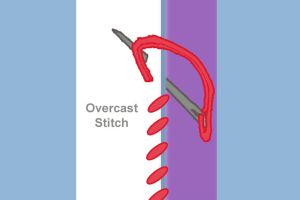Types Of Permanent Stitches | What is a permanent stitch?
Jump To:
Permanent stitches remain on the garment and form part of the stitched garment. They work instead of machine stitching. Permanent stitches are types of stitches that can be used for both decorative and functional purposes. These stitches last on the fabric sewn for the life of the garment or item. Permanent stitches are classified into running stitches, back stitches, overcast stitches, overhand, and whipping stitches. Running stitches are typically less in length.
What are the examples of permanent stitches?
Examples of permanent stitches are Running Stitches, Back Stitches, Run and backstitch, Heming Stitches, Decorative Stitches, Whipping stitch. But here we’ll look into 5 main permanent stitches.
Running Stitches
Running stitches are typically no more than in length. As long as the fabric allows, work with multiple needles on a long needle.
Very fine running stitches replace mechanical stitching in seams used in blouses and baby clothing.
Back Stitch
The backstitch is similar to a machine stitch on the right side, but unlike a machine stitch, the wrong side overlaps. Take a long-running stitch and reinsert the needle at the end of the first stitch, bringing it from the bottom forward and up through the surface one stitch length than the previous stitch. Repeat for the next stitch.
These stitches are most often used to form lines, outline shapes, and add fine details to embroidery drawings. Backstitches replace broken machine stitches and are mainly used for the beginning and end of embroidery.
Overcast Stitch

Blurred stitches are worked to prevent fraying of the blade edges and can be done on single or double edges. Grasp the raw edge of the seam with the thumb and finger of your left hand. Insert the needle behind and below the blade edge. Evenly space the stitches and place them twice as far apart as they are deep.
An overcast stitch is a type of stitch used to tie raw or unfinished seams or edges.
Overhand Stitch
Overhand stitches are similar to overcast but are made apart from the edges of the fabric. Insert the needle straight into your body and use a short needle to pick up a small needle.
The overhand stitch is used as a decorative stitch to join the edges and paint the hem. These types of stitches are used to apply lace or create a flat invisible seam where two folded edges are joined.
Whipping Stitch
Whipping is performed with a single thread of a matching color. Fold the hem allowance and work from right to left with the needle, grabbing one or two threads of fabric and one or two along the folds of the hem. There should be no visible stitches on the right side of the fabric.
Is tacking stitch permanent?
Besides being a temporary stitch, tacking can also be used as a permanent stitch to reinforce stress points on clothing or accessories such as pet harnesses, handbags, pants pockets, zipper flies, and skirt and jacket vents. There are several ways to sew a tacking stitch.
What are Neatening stitches?
NEATENING STITCHES. In tailoring and design, neatening stitches are used functionally to secure hems and turnings and to prevent raw edges from fraying. Fraying is the unraveling of threads in a cloth, forming loose threads at the edge or end.
What are permanent and temporary stitches?
Such stitches can be classified as temporary and permanent stitches. Temporary stitches. Such stitches are used to hold the garment or fabric pieces together before permanent stitches are made. These stitches are also known as tacking or basting stitches.
How do you Oversew?
What is the importance of permanent stitches?
Stay stitching is crucial to your sewing skills arsenal because it prevents stretching and distortion of your pattern pieces. Stay stitching is also used to reinforce corners, angles, and points. Most often, stay stitching is used on necklines, armholes, curves, and bias cuts.
What is decorative stitch?
Decorative Stitches are tiny bits of thread art by hand or machine. They may be adaptations of a zig-zag or patterns with a straight stitch. These stitches can be done in a variety of ways by changing the thread, width, and length of a stitch.
What is diagonal stitch?
A diagonal stitch is used on canvas and is applied to fill large areas with the effect of woven or brocaded material. It consists of a satin stitch (or tent stitch) being worked in diagonal rows from the top left to the bottom right-hand corner. A simpler form of the diagonal stitch is the mosaic stitch.
What is a French tack?
Tacking the lining loosely to the garment is a technique used in several Itch to Stitch’s patterns. These tacks are called “French Tacks”. The purpose of French tacks is to hold two layers of fabric loosely together, usually at the hem of a skirt and skirt lining.
